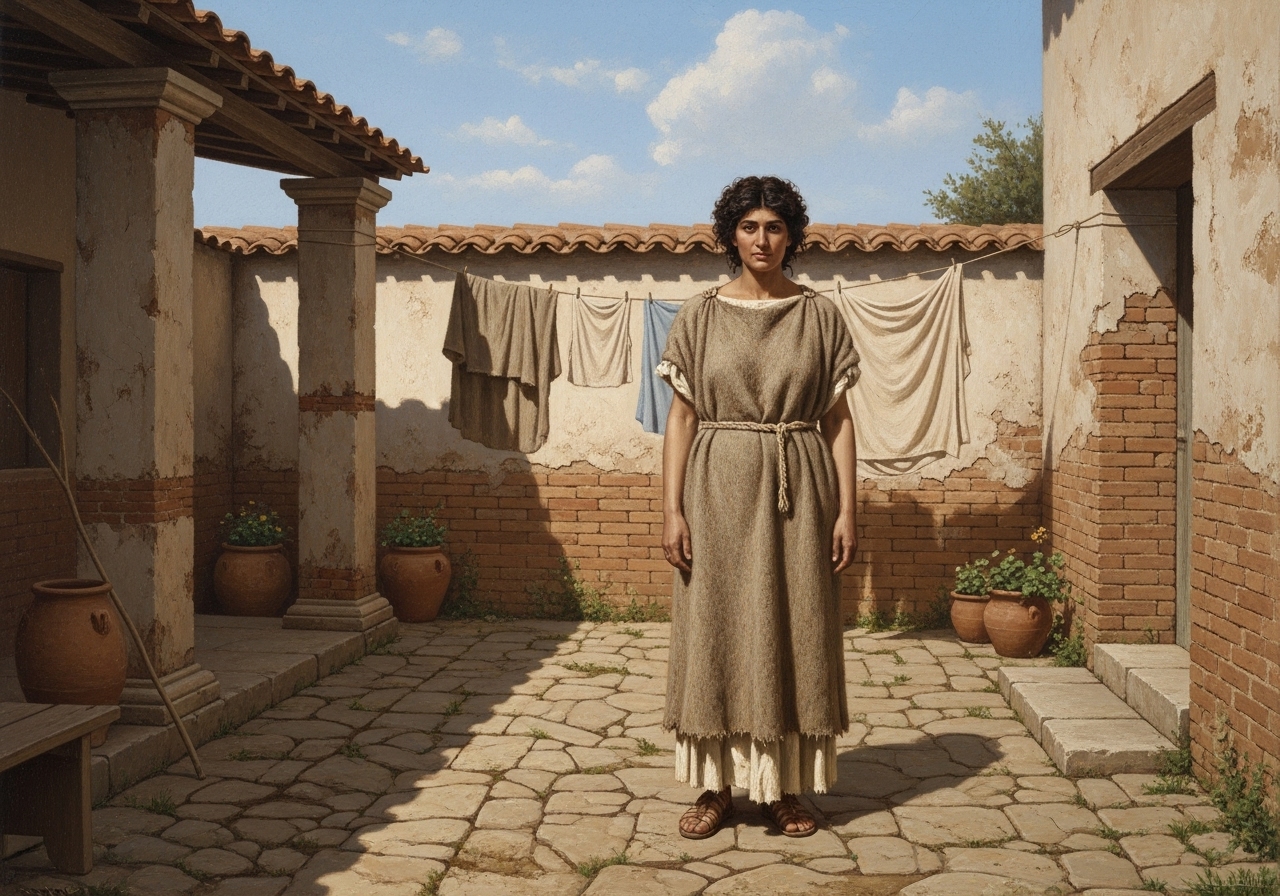<meta name='impact-site-verification' value='34369dc5-877c-4282-90a9-36f86721ccfa'>
Veiled in Virtue: The Enduring Allure of Roman Woman’s Clothing
Step into the world of ancient Rome, and you’ll discover a society where a woman’s attire was far more than mere covering. It was a public declaration of her identity, a symbol of her status, and a testament to her family’s standing. From the simple tunics of daily life to the opulent silks of the elite, female attire in ancient Rome was a rich tapestry woven with threads of tradition, modesty, and social significance. This article delves into the intricate world of Roman woman’s clothing, exploring the garments, fabrics, and evolving styles that defined a Roman woman’s life.
The Foundation of Roman Female Attire: Daily Garments
The core of a Roman woman’s wardrobe consisted of a few key garments, layered to suit the occasion and the weather. These pieces, while simple in their basic form, were distinguished by their fabric, color, and the way they were worn.
The Tunica: A Universal Garment

The fundamental item of clothing for all Romans, regardless of gender or class, was the tunica (tunic). For women, the tunic was typically longer than a man’s, often reaching the ankles or feet. In its most basic form, it was constructed from two rectangular pieces of wool or linen sewn together, with openings for the head and arms. Women’s tunics could be worn with or without sleeves and were often belted to define the figure. While a simple, undyed tunic was the everyday wear for lower-class women, wealthier women could afford tunics made of finer materials and in a variety of colors, sometimes wearing a lighter undertunic, or subucula, beneath.
The Stola: A Badge of Honor for the Roman Matron
The stola was the quintessential garment of a married Roman woman (matrona), a symbol of her respectability and marital status. This long, sleeveless dress was worn over a tunic and was typically suspended from the shoulders by straps, often fastened with decorative brooches called fibulae. It was a voluminous garment, often pleated and flowing to the feet, elegantly concealing the body and signifying modesty and adherence to tradition. So strong was its association with marital fidelity that it was forbidden for adulteresses and prostitutes to wear it. This restriction underscored the stola’s cultural importance as a marker of a woman’s moral character.
The Palla: An Elegant Outer Layer

When venturing outdoors, a respectable Roman woman would drape a palla over her stola. The palla was a large, rectangular shawl, often made of wool, that could be worn in various ways. A common method was to drape it over the left shoulder, bring it around the back and under the right arm, and then throw the remainder over the left arm or shoulder again. The palla was not only a practical garment for warmth but also a crucial accessory for modesty, as it could be pulled up to cover the head like a veil when in public. The manner of draping the palla also allowed for personal expression and could signal a woman’s elegance.
The Fabric of Roman Society: Materials and Colors
The materials and colors of a woman’s clothing were immediate indicators of her wealth and social standing.
From Humble Wool to Luxurious Silk
Wool was the most common fabric in ancient Rome, produced throughout Italy and valued for its durability. It was the primary material for tunics, stolas, and pallas. Linen, often imported from provinces like Egypt, was also widely used, especially for lighter garments in warmer weather.
For the wealthy elite, more exotic and expensive fabrics were available through Rome’s extensive trade networks. Cotton was imported from India, and silk from China was the ultimate luxury. Silk was so costly that the Emperor Tiberius once tried to prohibit men from wearing it, deeming it too effeminate. Initially used sparingly, perhaps as a decorative border, by the high Empire, affluent women could afford entire garments made of this coveted material.
A Spectrum of Meaning: The Symbolism of Color
While many Romans wore clothing in natural, undyed shades of cream and grey, those who could afford it embraced color. Dyes were expensive, making brightly colored garments a display of wealth. The symbolism of colors was also significant:
- White: Often associated with purity and worn by political candidates.
- Red: A powerful color linked to Mars, the god of war, and a symbol of power.
- Yellow: The color traditionally worn by brides at their wedding ceremony.
- Black or dark colors: Worn as a sign of mourning.
- Purple: Known as Tyrian purple, this was the most prestigious and expensive color, extracted from murex snails. Its use was heavily restricted by sumptuary laws, with solid purple garments generally reserved for the emperor.
A Reflection of Status: Clothing and the Social Hierarchy
In a society obsessed with status, a woman’s attire was a clear visual cue of her place in the world. The distinction between a respectable married woman in her stola and a prostitute (who sometimes wore a man’s toga as a mark of disgrace) is a stark example. Beyond this, the quality of fabric, the vibrancy of colors, and the intricacy of accessories all spoke to her family’s wealth and influence.
Sumptuary laws, like the Lex Oppia enacted in 215 BCE, attempted to curb what was seen as extravagant displays of wealth by women, limiting the amount of gold they could possess and restricting multi-colored garments. Though this law was eventually repealed after fierce protests by Roman matrons, the state’s impulse to regulate dress and maintain social order through clothing persisted throughout Roman history.
Adorning the Roman Woman: Jewelry, Accessories, and Hairstyles

With the relatively simple and slow-changing styles of their main garments, Roman women turned to accessories and elaborate hairstyles to express their individuality and fashion sense.
The Glitter of Gold: Roman Jewelry
Wealthy Roman women were avid collectors of jewelry and wore it in abundance. They adorned themselves with earrings (inaures), necklaces (monilia), bracelets (armillae), rings (anuli), and brooches (fibulae). These pieces were crafted from gold, silver, and bronze and often set with precious stones like emeralds, pearls, and garnets, as well as colored glass designed to imitate gems. Jewelry was considered a woman’s personal property, independent of her husband’s wealth, affording her a degree of financial autonomy.
Footwear and Undergarments
For footwear, Roman women wore sandals (soleae) indoors and closed-toed shoes (calcei) outdoors. Underneath their tunics, women wore a simple loincloth known as a subligaculum and often a breast band called a strophium or mamillare for support. The strophium was a band of linen or leather wrapped around the chest, partly for support but also to achieve the then-fashionable smaller-breasted silhouette.
Crowning Glory: The Art of Roman Hairstyles
Perhaps the most dynamic aspect of Roman female fashion was hairstyles. While Republican styles were often simple, featuring hair parted and tied in a modest bun at the nape (nodus), the Imperial era saw the rise of increasingly elaborate and sophisticated coiffures. Empresses and women of the imperial family were the ultimate trendsetters, their hairstyles immortalized on coins and in sculptures, which in turn were emulated by women across the empire.
These intricate styles often involved complex braids, curls piled high on the head, and the use of hairpieces, wigs made from the hair of conquered peoples (especially blond hair from Germany and Gaul), and even wire frames to create height and volume. Creating these hairstyles was a time-consuming process that required the skill of a dedicated slave hairdresser, the ornatrix.
From Republic to Empire: An Evolution of Style
The fashion of Roman women was not static; it evolved over the centuries, reflecting the changing social and political landscape.
In the early Roman Republic, female dress was austere, reflecting the traditional values of modesty and frugality. Clothing was largely homespun from wool.
With the expansion of the Republic and the rise of the Empire, Rome’s increasing wealth and exposure to other cultures brought new materials and influences. Fabrics became more luxurious, with silk and brightly colored dyes becoming more common among the elite. The Empire, particularly during the Flavian dynasty, was a period of great extravagance in hairstyles, with towering, curled creations becoming the height of fashion. While the core garments of the tunic, stola, and palla remained, the way they were adorned and the accessories that accompanied them became far more elaborate and ostentatious.
Frequently Asked Questions (FAQ)
1. What did a typical Roman woman wear every day?
A typical Roman woman’s daily attire consisted of a long, often sleeved tunic that reached her feet. If married, she wore a stola over the tunic as a symbol of her status. When going outdoors, she would drape a large rectangular shawl called a palla over her clothing, which could also be used to cover her head.
2. How did clothing show a woman’s status in ancient Rome?
Clothing was a primary indicator of a woman’s social standing. The most significant distinction was the stola, worn exclusively by respectable married women. The quality and color of the fabric were also key; expensive materials like silk and vibrant dyes such as purple were reserved for the wealthy elite. Lavish jewelry and complex, fashionable hairstyles further signified a woman’s high status.
3. What were the main fabrics used for Roman women’s clothing?
The most common fabrics were wool and linen, which were used for everyday garments. Wealthier Romans could also afford imported fabrics like cotton from India and, for the pinnacle of luxury, silk from China.
4. How did Roman women style their hair?
Roman hairstyles changed dramatically over time. In the Republic, styles were simpler, often a bun at the back of the neck. During the Empire, hairstyles became incredibly elaborate, especially for the elite. These complex creations featured high-piled curls, intricate braids, and the use of wigs, hairpieces, and wire frames to add volume and height, with empresses often setting the latest trends.
